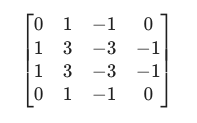convolutional neural networks coursera week 1 quiz answers
Quiz - The Basics of ConvNets
1. What do you think applying this filter to a grayscale image will do?

- Detect image contrast
- Detect 45 degree edges
- Detect horizontal edges
- Detect vertical edges
2. Suppose your input is a 300 by 300 color (RGB) image, and you are not using a convolutional network. If the first hidden layer has 100 neurons, each one fully connected to the input, how many parameters does this hidden layer have (including the bias parameters)?
- 9,000,100
- 27,000,100
- 9,000,001
- 27,000,001
3. Suppose your input is a 256 by 256 color (RGB) image, and you use a convolutional layer with 128 filters that are each 7 × 7 7×7. How many parameters does this hidden layer have (including the bias parameters)?
- 6400
- 1233125504
- 18816
- 18944
4. You have an input volume that is 121 × 121 × 16 121×121×16, and convolve it with 32 filters of 4 × 4 4×4, using a stride of 3 and no padding. What is the output volume?
- 40 x 40 x 32
- 118 × 118 × 32
- 40 x 40 x 16
- 118 x 118 × 16
5. You have an input volume that is 31x31x32, and pad it using “pad=1”. What is the dimension of the resulting volume (after padding)?
- 32x32x32
- 31x31x34
- 33x33x33
- 33x33x32
6. You have a volume that is 121 × 121 × 32 121×121×32, and convolve it with 32 filters of 5 × 5 5×5, and a stride of 1. You want to use a "same" convolution. What is the padding?
- 3
- 2
- 0
- 5
7. You have an input volume that is 128x128x12, and apply max pooling with a stride of 4 and a filter size of 4. What is the output volume?
- 64 x 64 x 12
- 128 × 128 × 3
- 32 x 32 x 3
- 32 x 32 × 12
8. Because pooling layers do not have parameters, they do not affect the backpropagation (derivatives) calculation.
- True
- False
9. Which of the following are true about convolutional layers? (Check all that apply)
- It allows parameters learned for one task to be shared even for a different task (transfer learning).
- It speeds up the training since we don’t need to compute the gradient for convolutional layers.
- It allows a feature detector to be used in multiple locations through the whole input volume.
- Convolutional layers provide separsity of connections.
10. In lecture we talked about “sparsity of connections” as a benefit of using convolutional layers. What does this mean?
- Each layer in a convolutional network is connected only to two other layers
- Regularization causes gradient descent to set many of the parameters to zero.
- Each filter is connected to every channel in the previous layer.
- Each activation in the next layer depends on only a small number of activations from the previous layer.
